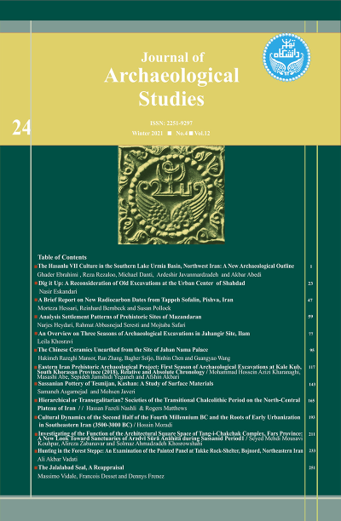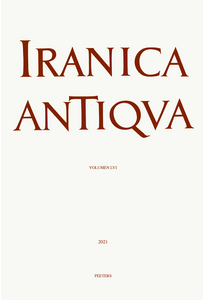Publications so far
0
| 1. |  | Hessari, Morteza; Bernbeck, Reinhard; Pollock, Susan: A Brief Report on New Radiocarbon Dates from Tappeh Sofalin, Pishva, Iran. In: Iranian Journal of Archaeological Studies, iss. 12, no. 4, pp. 49-61, 2021. (Type: Journal Article | Abstract | Links | BibTeX)@article{nokey,In the summer of 2017, renewed fieldwork was undertaken at Tappeh Sofalin in the Varamin Plain. A total of 20 samples for absolute dating were collected during this season, several of which have been analyzed. We present this new evidence for the dating of the site and compare it briefly with published dates and analyses from other sites. Finally, we discuss implications for the chronology of the Proto-Elamite spread to the Central Plateau and other areas of Iran. |
| 2. |  | Amelirad, Sheler; Azizi, Eghbal: Kani Koter, Iron Age Cemetery from Iranian Kurdistan. In: Iran, vol. 59, iss. 1, pp. 57-76, 2019. (Type: Journal Article | Abstract | Links | BibTeX)@article{nokey,Kani Koter cemetery is located in Iranian Kurdistan, close to Dere Pemeyan (or Persian Dare Panbedan) village, between the ancient sites of Ziwiye and Karafto Cave (Figure 1). In this article, we discuss the material discovered from one of the graves in this cemetery, its chronology, and cultural associations. Unfortunately, tomb robbers plundered this grave, completely ruining the tomb's stratigraphic context. Fortunately, in 2016 the Cultural Heritage Organization of Kurdistan rescued all of the stolen artefacts, and today the collection is stored at the Sanandaj Museum. The grave has yielded a number of elaborately decorated objects that belong nominally to Assyrian, Urartian and Mannaean artistic traditions, with the date for the finds being established by means of comparisons with Assyrian and Urartian artefacts. |
| 3. |  | Amelirad, Sheler; Mohajerynezhad, Abdolrezer; Javidkhah, Masoume: A Report on the Excavation at the Mala Mcha Graveyard, Kurdistan, Iran. In: Iran, vol. 55, iss. 2, pp. 171-207, 2017. (Type: Journal Article | Abstract | Links | BibTeX)@article{nokey,The Mala Mcha graveyard is located in Iranian Kurdistan, near the ancient Mannaean site of Ziwiya. Abdolreza Mohajerynezhad and Rasol Oshtodan conducted rescue excavations at Mala Mcha in 2012, and 16 graves were uncovered. Although most of the graves had been plundered by tomb robbers the tomb structures, and especially the grave-goods that remained, suggest an Iron Age III date and close relations with neighbouring sites such as Ziwiye, Qalaichi and Changbar. Most of the graves were covered with large flat slabs and contained one, two or three burials, the exception being tomb no. 7 with 14 burials. |
| 4. |  | Amelirad, Sheler; Overlaet, Bruno; Haerinck, Ernie: The Iron Age “Zagros Graveyard” Near Sanandaj (Iranian Kurdistan): Preliminary Report on the First Season. In: Iranica Antiqua, vol. 47, pp. 41-99, 2012. (Type: Journal Article | Abstract | Links | BibTeX)@article{nokey,An Iron Age graveyard, for the most part dating from the 8th - 7th century BC, was accidentally discovered in 2008 during road works near Sanandaj, Iranian Kurdistan. Rescue excavations were conducted by the Cultural Heritage Department in Sanandaj. The present contribution reports on these first excavations during which more than 20 graves were discovered in two squares and a trench. A selection of the graves and the burial goods are discussed. |
| 5. | Gordon, D. H.: The Chronology of the Third Cultural Period at Tepe Hissar. In: Iraq, vol. 13, pp. 40-61, 1951. (Type: Journal Article | Links | BibTeX)@article{nokey, |
2021 |
|
 | Hessari, Morteza; Bernbeck, Reinhard; Pollock, Susan: A Brief Report on New Radiocarbon Dates from Tappeh Sofalin, Pishva, Iran. In: Iranian Journal of Archaeological Studies, iss. 12, no. 4, pp. 49-61, 2021. (Type: Journal Article | Abstract | Links | BibTeX | Tags: Chronology, Dating, Elam, Tehran)@article{nokey,In the summer of 2017, renewed fieldwork was undertaken at Tappeh Sofalin in the Varamin Plain. A total of 20 samples for absolute dating were collected during this season, several of which have been analyzed. We present this new evidence for the dating of the site and compare it briefly with published dates and analyses from other sites. Finally, we discuss implications for the chronology of the Proto-Elamite spread to the Central Plateau and other areas of Iran. |
2019 |
|
 | Amelirad, Sheler; Azizi, Eghbal: Kani Koter, Iron Age Cemetery from Iranian Kurdistan. In: Iran, vol. 59, iss. 1, pp. 57-76, 2019. (Type: Journal Article | Abstract | Links | BibTeX | Tags: Chronology, Iron Age, Kurdistan, Material Analysis)@article{nokey,Kani Koter cemetery is located in Iranian Kurdistan, close to Dere Pemeyan (or Persian Dare Panbedan) village, between the ancient sites of Ziwiye and Karafto Cave (Figure 1). In this article, we discuss the material discovered from one of the graves in this cemetery, its chronology, and cultural associations. Unfortunately, tomb robbers plundered this grave, completely ruining the tomb's stratigraphic context. Fortunately, in 2016 the Cultural Heritage Organization of Kurdistan rescued all of the stolen artefacts, and today the collection is stored at the Sanandaj Museum. The grave has yielded a number of elaborately decorated objects that belong nominally to Assyrian, Urartian and Mannaean artistic traditions, with the date for the finds being established by means of comparisons with Assyrian and Urartian artefacts. |
2017 |
|
 | Amelirad, Sheler; Mohajerynezhad, Abdolrezer; Javidkhah, Masoume: A Report on the Excavation at the Mala Mcha Graveyard, Kurdistan, Iran. In: Iran, vol. 55, iss. 2, pp. 171-207, 2017. (Type: Journal Article | Abstract | Links | BibTeX | Tags: Chronology, Excavation, Iron, Iron Age, Kurdistan, Zagros Highlands)@article{nokey,The Mala Mcha graveyard is located in Iranian Kurdistan, near the ancient Mannaean site of Ziwiya. Abdolreza Mohajerynezhad and Rasol Oshtodan conducted rescue excavations at Mala Mcha in 2012, and 16 graves were uncovered. Although most of the graves had been plundered by tomb robbers the tomb structures, and especially the grave-goods that remained, suggest an Iron Age III date and close relations with neighbouring sites such as Ziwiye, Qalaichi and Changbar. Most of the graves were covered with large flat slabs and contained one, two or three burials, the exception being tomb no. 7 with 14 burials. |
2012 |
|
 | Amelirad, Sheler; Overlaet, Bruno; Haerinck, Ernie: The Iron Age “Zagros Graveyard” Near Sanandaj (Iranian Kurdistan): Preliminary Report on the First Season. In: Iranica Antiqua, vol. 47, pp. 41-99, 2012. (Type: Journal Article | Abstract | Links | BibTeX | Tags: Ceramics, Chronology, Excavation, Iron, Iron Age, Kurdistan, Pottery, Zagros, Zagros Highlands)@article{nokey,An Iron Age graveyard, for the most part dating from the 8th - 7th century BC, was accidentally discovered in 2008 during road works near Sanandaj, Iranian Kurdistan. Rescue excavations were conducted by the Cultural Heritage Department in Sanandaj. The present contribution reports on these first excavations during which more than 20 graves were discovered in two squares and a trench. A selection of the graves and the burial goods are discussed. |
1951 |
|
Gordon, D. H.: The Chronology of the Third Cultural Period at Tepe Hissar. In: Iraq, vol. 13, pp. 40-61, 1951. (Type: Journal Article | Links | BibTeX | Tags: Chronology)@article{nokey, | |
